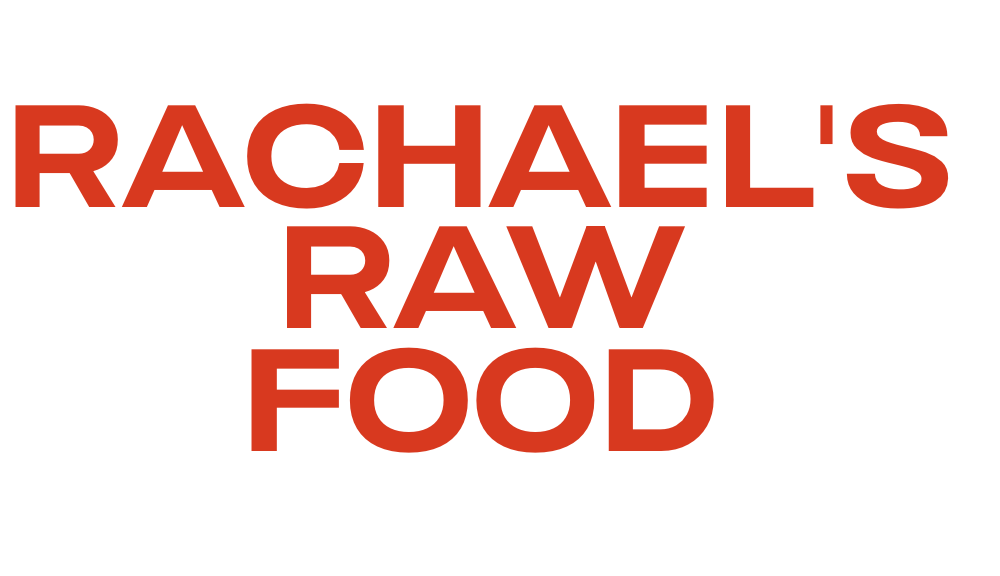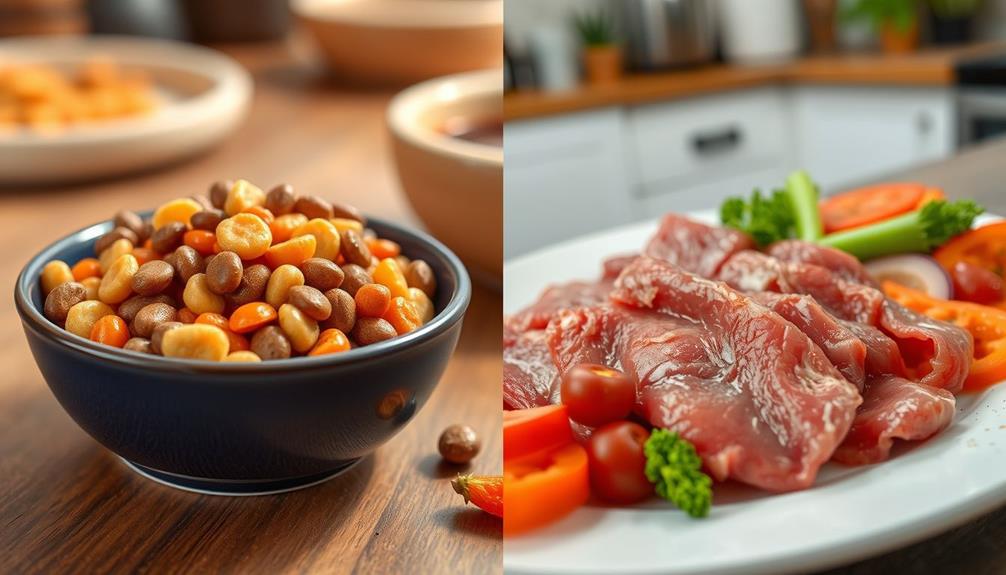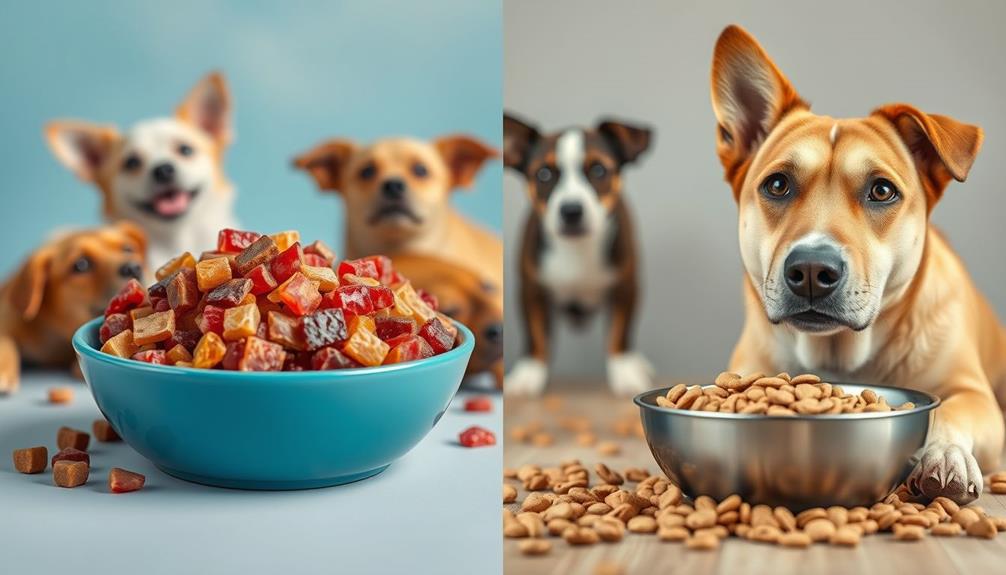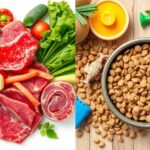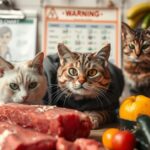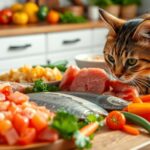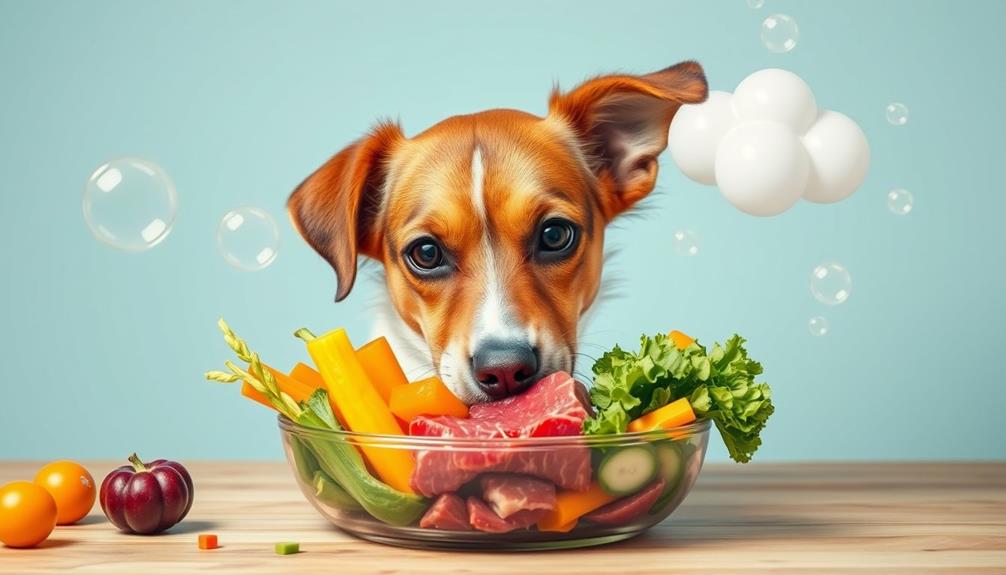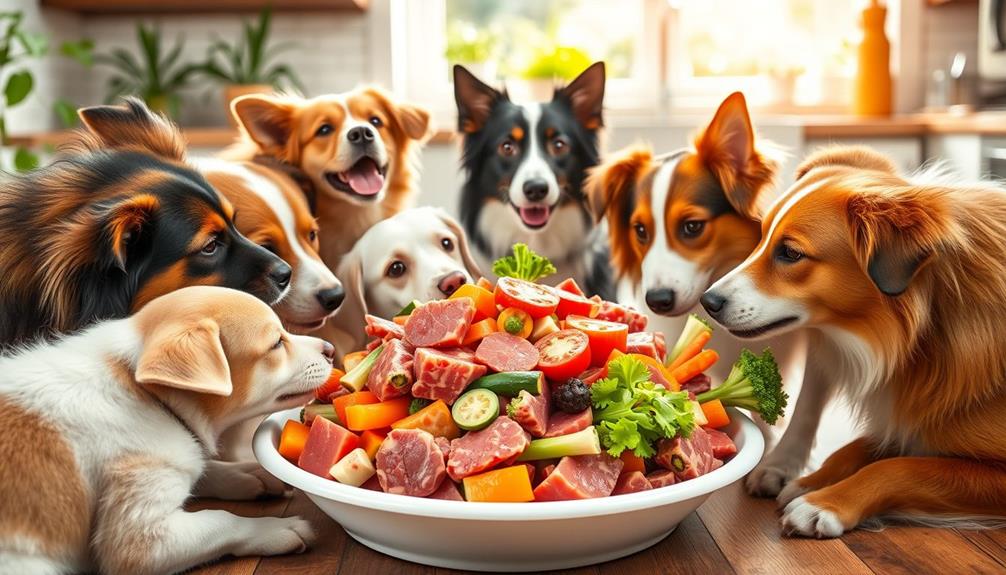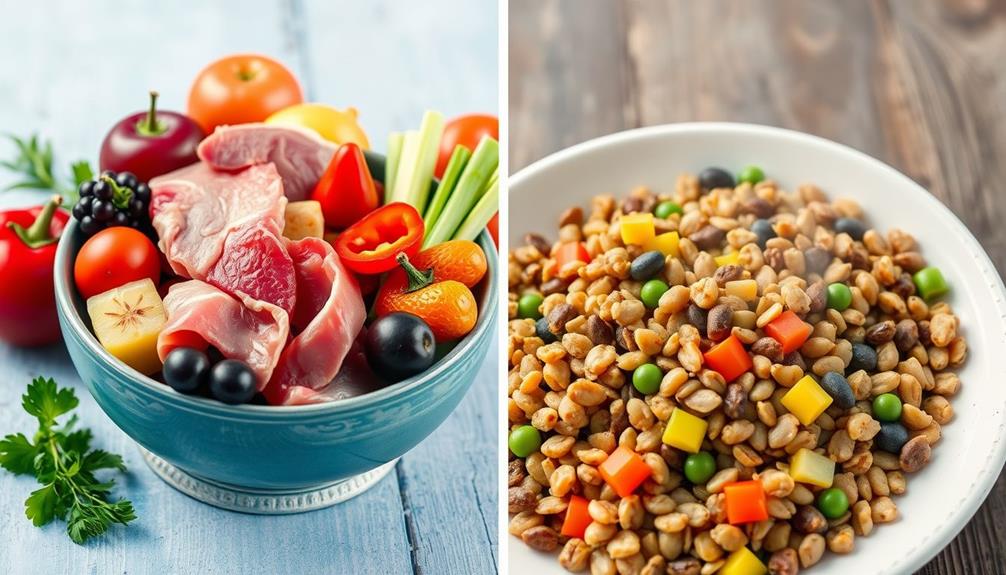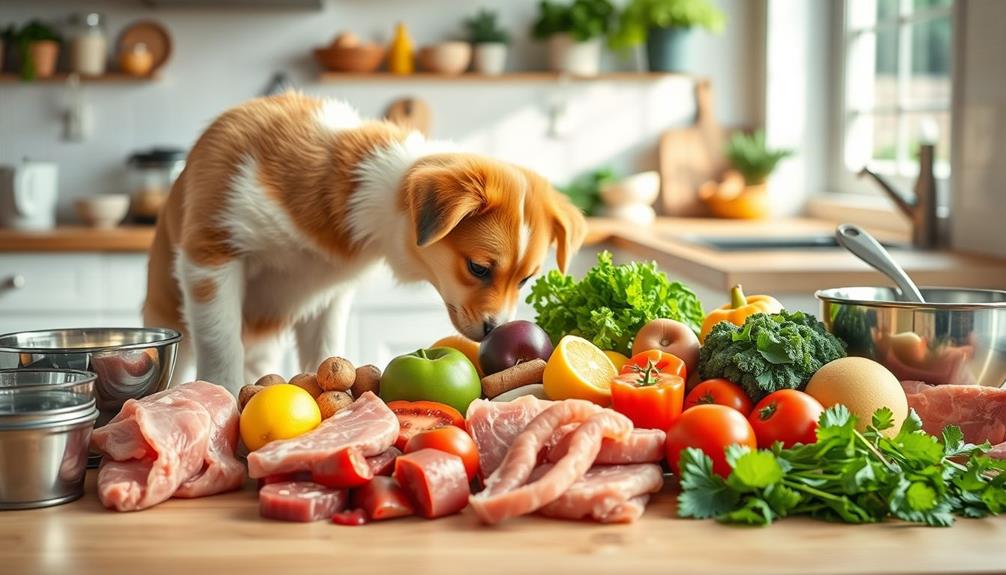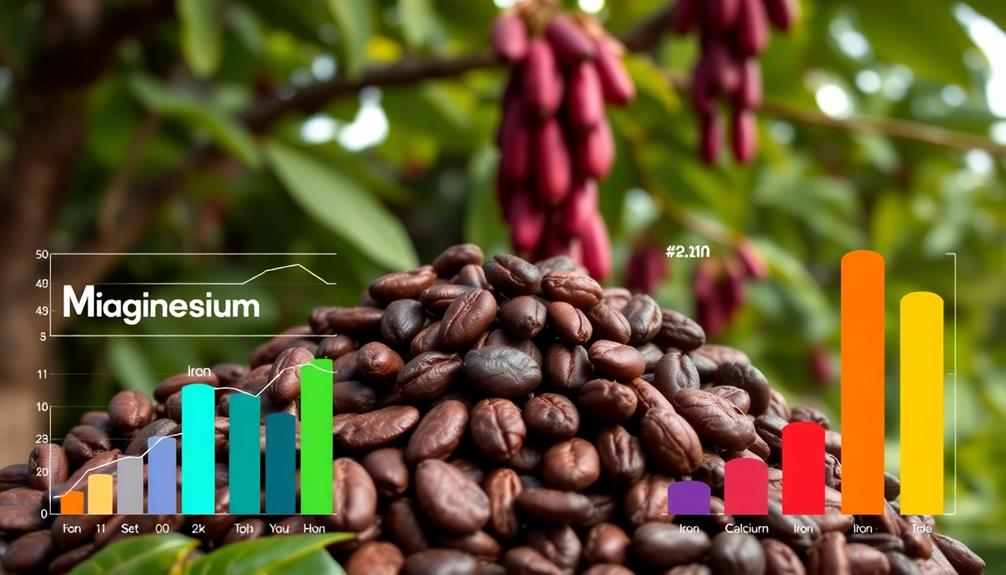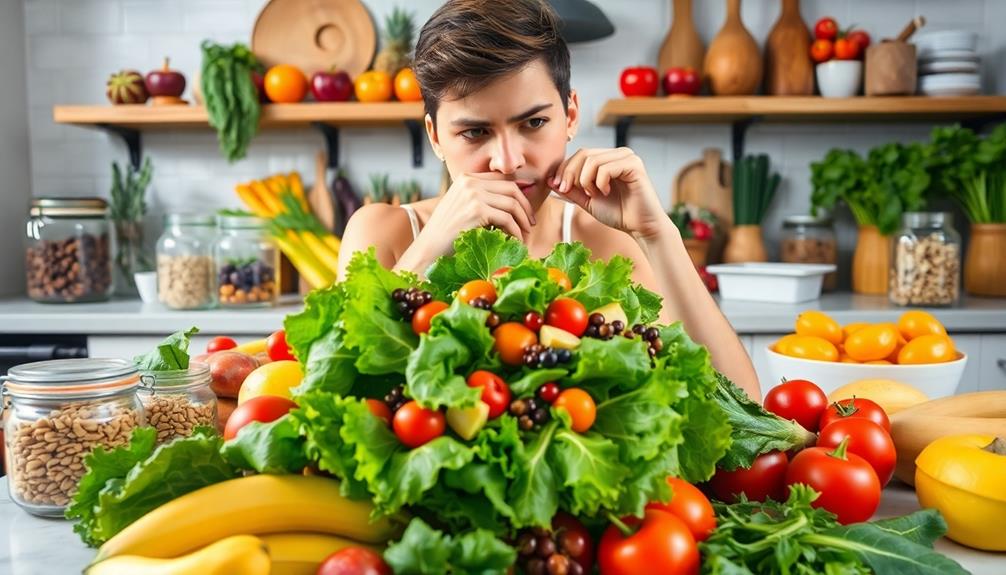When you're weighing wet food versus raw food for your cat, consider both benefits and risks. Wet food offers high moisture content, essential for hydration and preventing kidney issues. It's safer, with balanced nutrition, and often more appealing to picky eaters. On the other hand, raw food boasts high protein but carries risks of contamination with harmful bacteria. Making the right choice can promote your cat's health, so think about your pet's needs and lifestyle. If you want to explore deeper insights and specifics on feeding options, there's more valuable information ahead.
Key Takeaways
- Wet food provides high moisture content, promoting hydration and reducing the risk of kidney and bladder diseases in cats.
- Raw food diets can offer high protein levels, but they carry significant risks of pathogen contamination, especially for vulnerable cats.
- Wet food is generally safer and more convenient to handle compared to raw meat, reducing health risks for both pets and owners.
- Nutritional balance in wet food is easier to achieve, ensuring cats receive essential vitamins and minerals without the complexities of raw diets.
- Transitioning to wet food can support better metabolic health and aid in weight management, making it a preferable choice for many cat owners.
Overview of Cat Nutrition
When considering what to feed your cat, it's essential to understand their unique nutritional needs. As obligate carnivores, cats require a diet rich in animal protein to thrive. Essential nutrients such as taurine, arachidonic acid, and specific vitamins are imperative for their best health. A raw food diet or high-quality wet food can provide complete and balanced nutrition, ensuring your cat gets everything they need.
Proper hydration also plays a considerable role, as hamster care guidelines emphasize the importance of moisture in diets, which can be applicable to other pets as well.
Hydration is another key factor in cat nutrition. Cats naturally consume about 70% water in their prey diet, so incorporating moisture-rich foods like wet food or raw diets can help maintain hydration. Wet food contains around 78% water, which greatly aids in reducing the risk of kidney and bladder health problems linked to chronic dehydration from kibble.
When you choose high-protein, high-moisture diets, your cat is likely to maintain healthier body conditions and energy levels. This is particularly important when comparing wet food and raw diets against low-moisture, high-carbohydrate kibble.
Ensuring your cat's diet meets these nutritional requirements will lead to a happier, healthier feline companion.
Benefits of Wet Cat Food
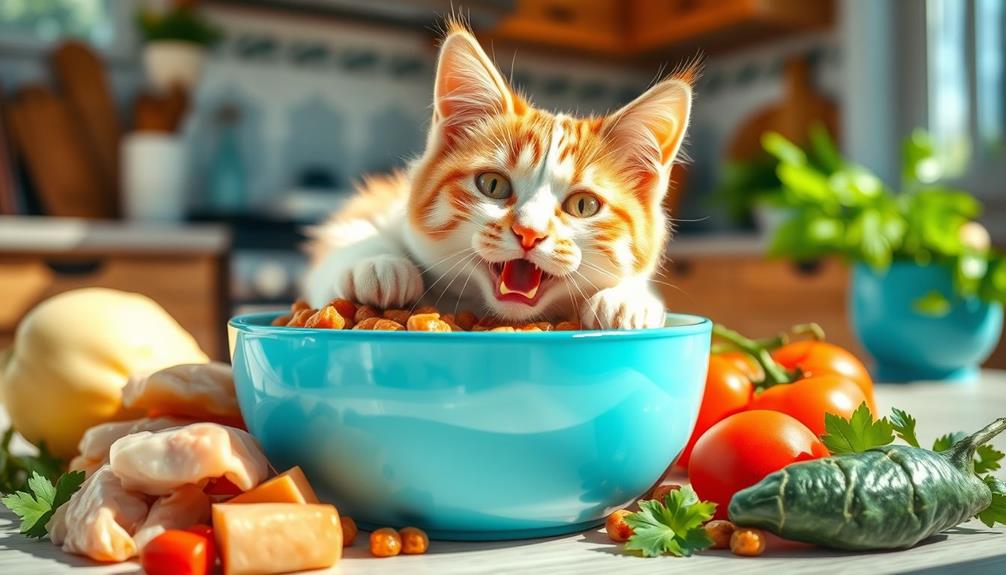
When it comes to your cat's hydration and overall health, wet cat food offers significant benefits.
With about 78% water content, it can help keep your feline friend well-hydrated, reducing the risk of kidney and bladder issues.
Additionally, wet food can contribute to maintaining a healthy weight, as it often contains fewer calories compared to dry food, making it a smart choice for cats prone to obesity common types of cold medications.
Plus, the enticing aroma and taste make it a great choice for even the pickiest eaters.
Hydration and Health Benefits
Wet cat food offers considerable hydration benefits that can greatly enhance your cat's overall health. With about 78% water content, wet food provides essential hydration, preventing chronic dehydration that can lead to serious health complications.
Additionally, incorporating wet food can be likened to using essential oils for health, as it supports a well-rounded diet that promotes vitality. When you choose high-quality wet food, you're helping your cat drink adequate water, markedly reducing the risk of kidney diseases and bladder issues often caused by dehydration.
This high moisture content is particularly beneficial for male cats, as it helps prevent painful urethral obstructions associated with urinary tract issues. By incorporating wet food into your cat's diet, you're not just offering hydration; you're also promoting a balanced diet that supports their overall health.
Regular consumption can lower the likelihood of chronic health issues, such as obesity, diabetes, and kidney failure, due to its lower carbohydrate levels.
Investing in high-quality wet food ultimately helps you avoid expensive health complications related to dehydration, ensuring your feline companion lives a longer, healthier life.
Nutritional Quality Comparison
Choosing the right food for your cat is essential, and wet cat food often stands out for its nutritional quality. Unlike dry options, wet food contains about 78% water, promoting hydration and helping to prevent kidney and bladder diseases.
Additionally, wet food is rich in antioxidants, which can contribute to overall health, making it a beneficial choice for your feline friend antioxidant-rich benefits. High-quality canned cat food is designed to provide balanced nutrition, meeting your cat's unique dietary needs without the risks associated with raw diets.
You'll find that many wet food options are formulated with high protein levels and essential nutrients, ensuring your feline friend gets the nourishment they require. The appealing aroma and flavor of wet food can also entice even the pickiest eaters, making it easier for them to consume adequate nutrition daily.
Regularly feeding your cat wet food has been linked to better overall health outcomes, including effective weight management and reduced risks of chronic health issues.
Pros and Cons of Raw Cat Food
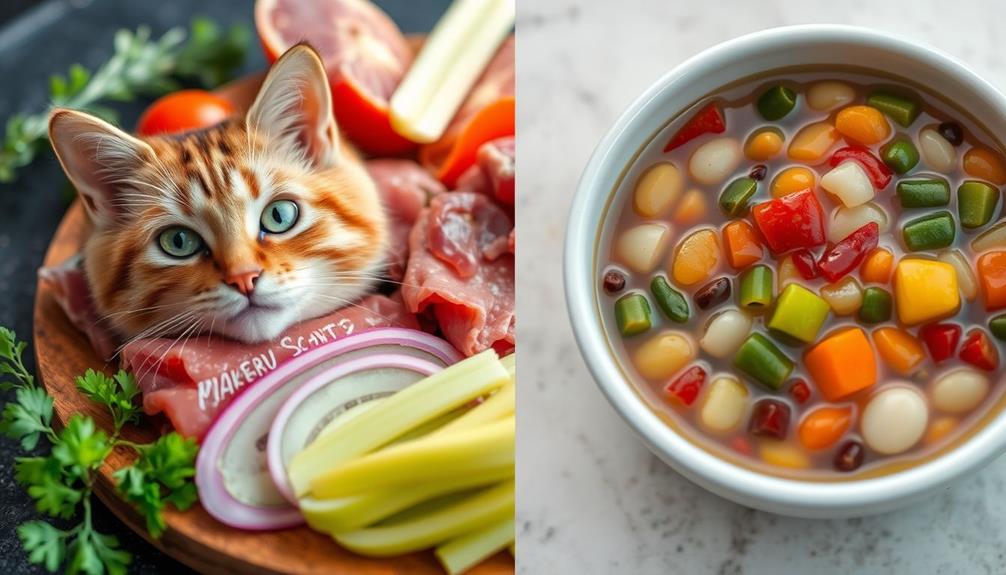
Raw cat food has gained popularity among some pet owners due to its potential health benefits, but it's important to evaluate both the pros and cons. One of the main advantages of feeding raw is the high protein content, which aligns with a cat's obligate carnivore diet. Many believe that raw diets can enhance energy levels and promote overall health.
Additionally, raw cat foods can provide balanced nutrition if prepared correctly, including vital vitamins and minerals. Just like dogs, cats can benefit from healthy snacks that support their overall well-being.
However, there are significant risks of contamination associated with raw feeding. Pathogens like Salmonella and E. Coli can pose health threats, especially in households with vulnerable individuals. Many veterinarians express concern over the potential health risks for both pets and humans, suggesting that cooked alternatives are safer while still preserving nutritional benefits.
Moreover, ensuring a homemade raw diet is nutritionally balanced can be challenging without proper knowledge and resources. While raw diets may have benefits, high-quality canned food can often deliver similar hydration and nutrient content without the associated risks.
Ultimately, it's vital to examine these factors when deciding what's best for your pet's health.
Safety and Hygiene Issues
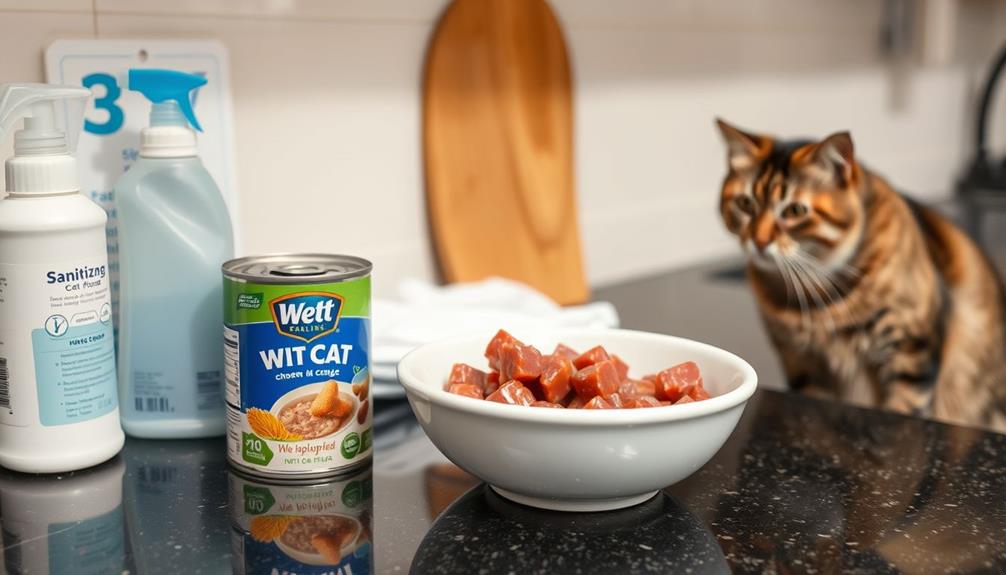
When considering a raw food diet for your cat, you need to be aware of the higher risk of pathogen contamination, like Salmonella and E. coli.
This is particularly important for families with elderly members or caregivers who are responsible for their well-being, as financial considerations for elderly care can complicate health-related decisions.
Safe handling practices are vital; always wash your hands and clean surfaces thoroughly after dealing with raw meat.
If you have vulnerable individuals in your home, weighing these hygiene concerns is essential before making a decision.
Pathogen Contamination Risks
Feeding your cat a raw diet comes with significant pathogen contamination risks that can compromise both your pet's health and your household's safety.
Raw cat food diets often harbor harmful microorganisms like Salmonella, E. Coli, and Toxoplasma gondii. Therefore, it's essential to understand the importance of creating a personal budget for pet care expenses, especially when considering financial planning for pet care.
The USDA estimates that 25% of raw chicken is contaminated during food production, increasing the likelihood of exposure for your pet. Cats, especially young, old, or immunocompromised ones, are at a higher risk for diseases linked to raw food due to these pathogens.
Bacterial counts can remain high even after freezing or dehydrating raw meat, which means that simply relying on these methods doesn't eliminate the risk.
As a pet parent, it's important to be aware of the health risks associated with feeding raw diets. Households with young children or immunocompromised individuals should exercise extra caution.
Pathogen contamination can pose serious threats not only to your cat but also to vulnerable family members. While many pet parents are passionate about raw feeding, understanding these risks is significant for making an informed decision about your cat's diet.
Safe Handling Practices
Handling raw cat food requires strict adherence to safe practices to minimize the risk of contamination. Raw pet foods can harbor harmful pathogens like Salmonella and E. Coli, so knowing how to handle them safely is vital.
Air purifier maintenance can also contribute to a healthier environment for your pets by reducing airborne allergens.
Here are some essential safe handling practices to follow:
- Always wash your hands thoroughly after handling raw meat.
- Disinfect all surfaces and utensils used during preparation.
- Keep raw food separate from other food items to avoid cross-contamination.
- Avoid rinsing raw meat, as this can spread bacteria onto surfaces.
- Immediately refrigerate or discard any uneaten pet food.
Transitioning Between Food Types
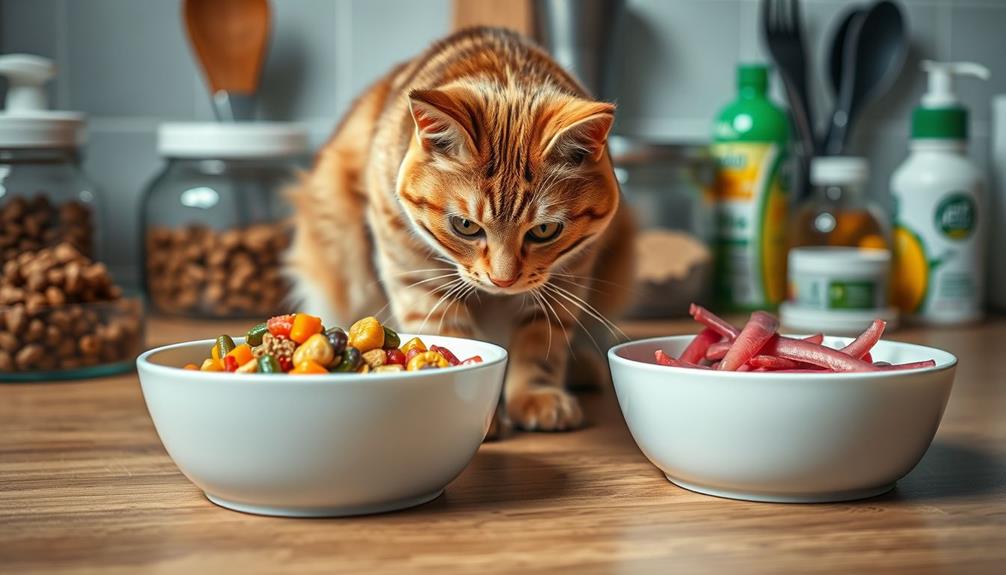
Changing your cat from dry kibble to wet or raw food can be a smooth process with the right approach. Start by removing dry food at night and introducing moist food, like canned food, the next morning. Cats often find strong-smelling moist foods more appealing, making it easier for them to accept new options.
Gradually mix different meat sources into their diet to diversify flavors and textures, helping them adjust to the new food type. Additionally, incorporating gentle routines around mealtime can help reduce stress and create a positive feeding environment, similar to how yoga can alleviate stress and improve overall well-being.
You can also enhance their meals by adding enticing toppings, like crushed freeze-dried chicken or warm water. These simple additions can encourage your cat to try and enjoy their new meals.
During this change, consider implementing timed feeding instead of free-feeding. This not only promotes healthier eating habits but also helps prevent obesity, making it a great strategy as you shift to wet or raw diets.
Making the Best Choice

When deciding between wet food and raw food for your cat, it's essential to weigh the benefits and potential risks of each option. Wet food generally offers better hydration, which is vital for preventing kidney and bladder diseases. Additionally, developmental milestones assessed in pets can be influenced by their nutrition, which emphasizes the importance of proper dietary choices.
While both options can provide high protein levels, wet food guarantees your cat meets its nutritional needs without the risks associated with raw diets.
Consider these points when making your choice:
- Wet food contains about 78% water, aiding in hydration.
- High-quality wet food can help mitigate chronic health issues.
- Raw diets may pose contamination risks, especially in homes with vulnerable individuals.
- Shifting to wet food can help prevent obesity and support better metabolic health.
- Wet food is more convenient and safer for handling compared to raw meat.
Ultimately, while raw food aligns with a cat's ancestral diet, wet food is often the safer and more practical choice. Raw food for cats may pose the risk of bacterial contamination, as well as the potential for nutrient imbalances if not carefully formulated. Wet food, on the other hand, provides the benefits of moisture content and balanced nutrition, making it a more convenient and reliable option for cat owners. While raw food for cats may be appealing for its natural and ancestral qualities, the practicality and safety of wet food make it a better choice for overall feline health and well-being.
Prioritize your cat's health and well-being by making sure they receive adequate hydration and nutrition, minimizing health risks associated with raw diets.
Frequently Asked Questions
Do Cats Live Longer on a Raw Diet?
You might find that cats on a raw diet can show improved health and energy levels, but current research doesn't conclusively prove they live longer. Factors like genetics and environment play significant roles too.
Do Vets Recommend Wet or Dry Food for Cats?
Imagine your cat savoring a delicious, juicy meal rather than crunching on dry morsels. Most vets recommend wet food for its hydration benefits, appealing taste, and better alignment with your feline's natural dietary needs.
Why Is Raw Cat Food Better?
Raw cat food's often better because it mirrors their natural diet, providing essential proteins and nutrients. You'll notice improvements in your cat's energy, weight management, and overall health, especially if they have food sensitivities.
Is It Better for Cats to Eat Only Wet Food?
If you feed your cat only wet food, you're likely enhancing their hydration and reducing health risks. This diet aligns better with their natural needs, promoting overall well-being and potentially preventing issues like urinary tract blockages.
Conclusion
Ultimately, the best choice for your cat depends on their unique needs and preferences. While some might worry about the safety of raw food, with proper handling and sourcing, it can be a nutritious option. However, wet food often provides hydration and essential nutrients that many cats thrive on. You know your pet best, so consider their health, lifestyle, and what they enjoy most. Trust your instincts, and your cat will thank you for it!
